Comprehensive Analysis of Plastic Waste Management Strategies
VerifiedAdded on 2023/02/01
|20
|5720
|83
Report
AI Summary
This report provides a comprehensive literature review on the management of plastic waste. It begins with an introduction to plastic and its widespread use, followed by a discussion of the environmental hazards associated with improper disposal. The review explores various strategies for managing plastic waste, including recycling, reusing, and minimizing plastic usage. It also examines incineration and landfilling as disposal methods, while highlighting the importance of promoting plastic alternatives and biodegradable plastics. The report emphasizes the increasing need for effective plastic waste management due to the escalating production and accumulation of plastic waste, its impact on ecosystems, and the importance of maintaining ecological balance. The report underscores the urgency of implementing sustainable practices to mitigate the adverse effects of plastic pollution and protect the environment.
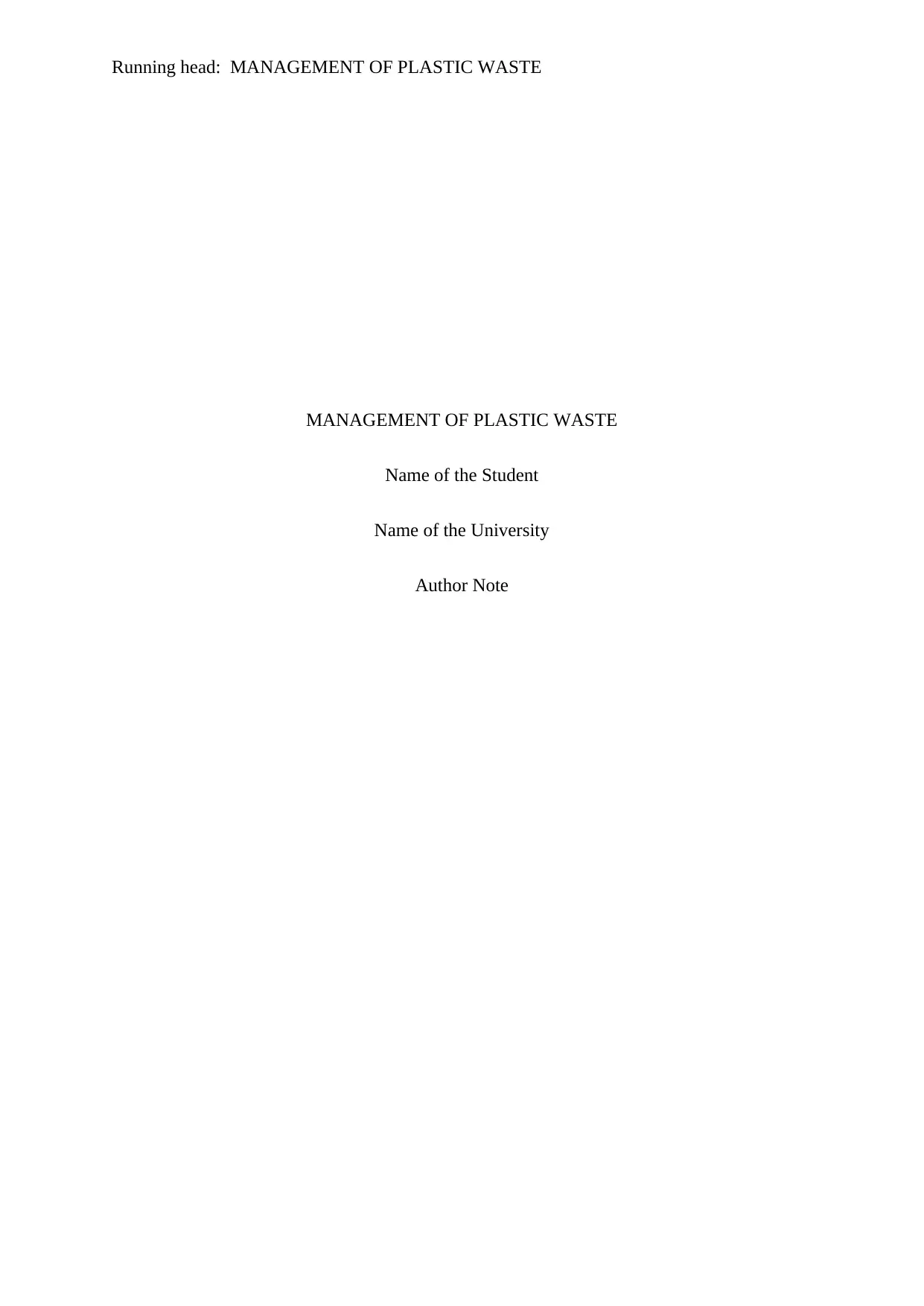
Running head: MANAGEMENT OF PLASTIC WASTE
MANAGEMENT OF PLASTIC WASTE
Name of the Student
Name of the University
Author Note
MANAGEMENT OF PLASTIC WASTE
Name of the Student
Name of the University
Author Note
Paraphrase This Document
Need a fresh take? Get an instant paraphrase of this document with our AI Paraphraser
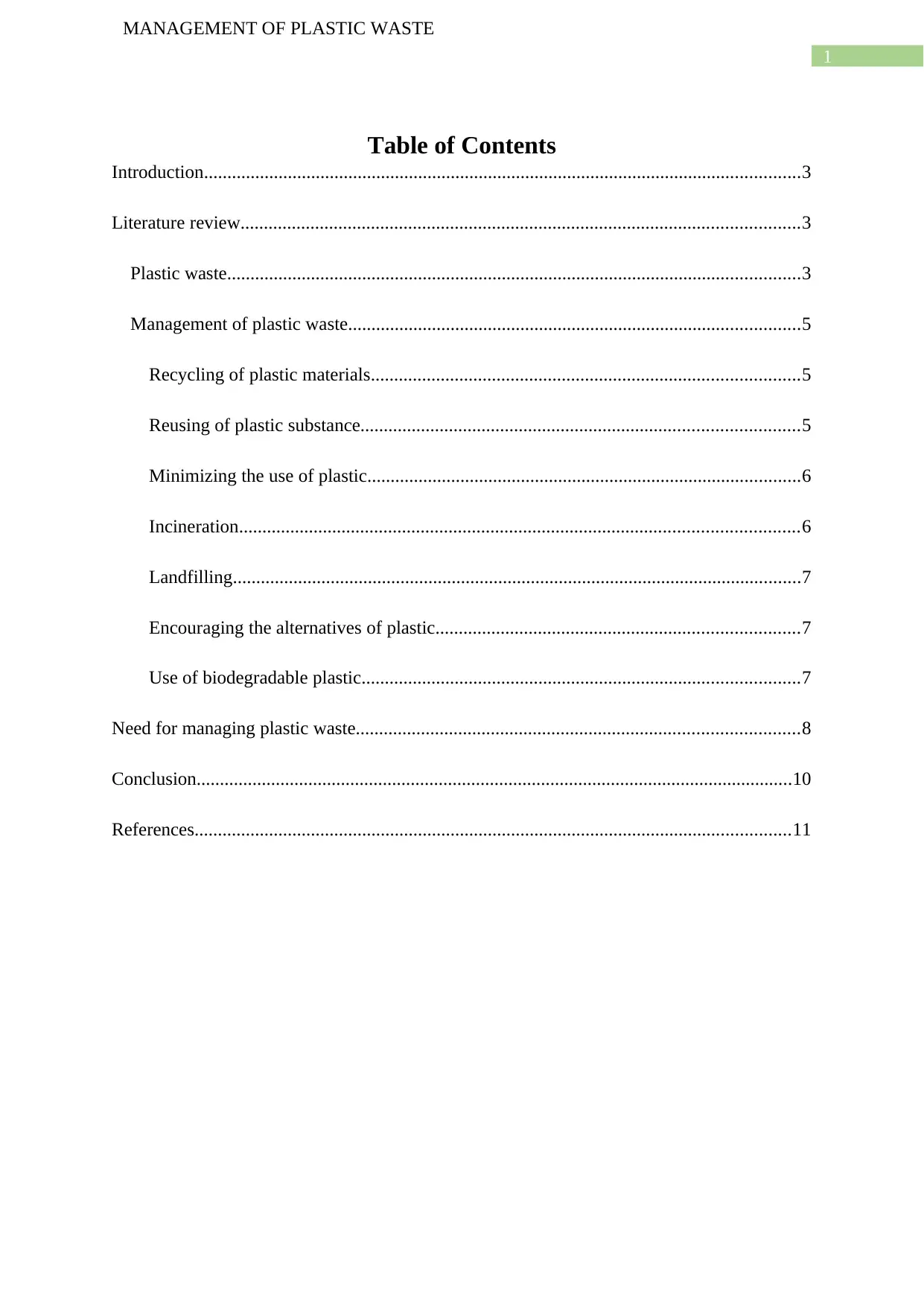
1
MANAGEMENT OF PLASTIC WASTE
Table of Contents
Introduction................................................................................................................................3
Literature review........................................................................................................................3
Plastic waste...........................................................................................................................3
Management of plastic waste.................................................................................................5
Recycling of plastic materials............................................................................................5
Reusing of plastic substance..............................................................................................5
Minimizing the use of plastic.............................................................................................6
Incineration........................................................................................................................6
Landfilling..........................................................................................................................7
Encouraging the alternatives of plastic..............................................................................7
Use of biodegradable plastic..............................................................................................7
Need for managing plastic waste...............................................................................................8
Conclusion................................................................................................................................10
References................................................................................................................................11
MANAGEMENT OF PLASTIC WASTE
Table of Contents
Introduction................................................................................................................................3
Literature review........................................................................................................................3
Plastic waste...........................................................................................................................3
Management of plastic waste.................................................................................................5
Recycling of plastic materials............................................................................................5
Reusing of plastic substance..............................................................................................5
Minimizing the use of plastic.............................................................................................6
Incineration........................................................................................................................6
Landfilling..........................................................................................................................7
Encouraging the alternatives of plastic..............................................................................7
Use of biodegradable plastic..............................................................................................7
Need for managing plastic waste...............................................................................................8
Conclusion................................................................................................................................10
References................................................................................................................................11
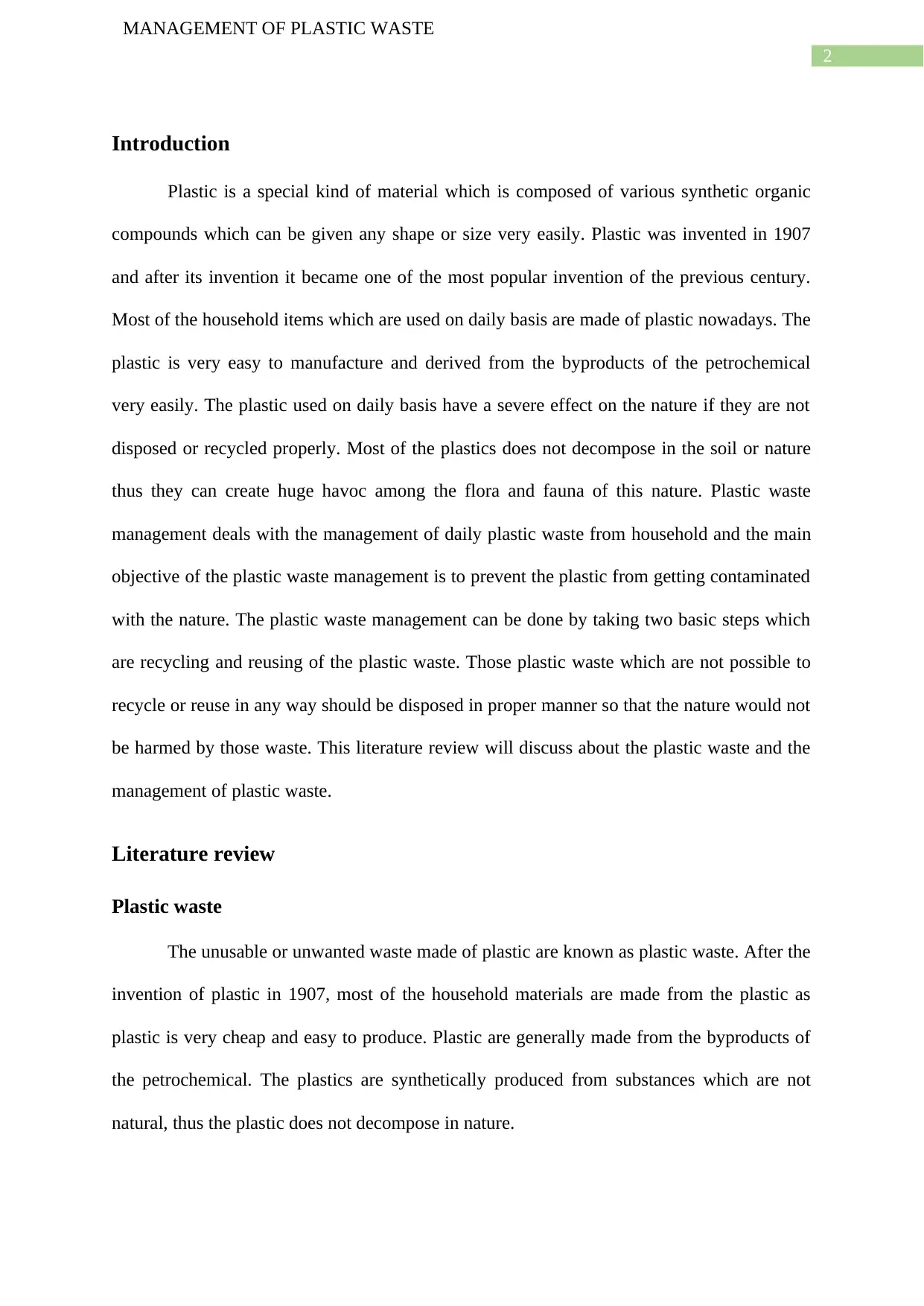
2
MANAGEMENT OF PLASTIC WASTE
Introduction
Plastic is a special kind of material which is composed of various synthetic organic
compounds which can be given any shape or size very easily. Plastic was invented in 1907
and after its invention it became one of the most popular invention of the previous century.
Most of the household items which are used on daily basis are made of plastic nowadays. The
plastic is very easy to manufacture and derived from the byproducts of the petrochemical
very easily. The plastic used on daily basis have a severe effect on the nature if they are not
disposed or recycled properly. Most of the plastics does not decompose in the soil or nature
thus they can create huge havoc among the flora and fauna of this nature. Plastic waste
management deals with the management of daily plastic waste from household and the main
objective of the plastic waste management is to prevent the plastic from getting contaminated
with the nature. The plastic waste management can be done by taking two basic steps which
are recycling and reusing of the plastic waste. Those plastic waste which are not possible to
recycle or reuse in any way should be disposed in proper manner so that the nature would not
be harmed by those waste. This literature review will discuss about the plastic waste and the
management of plastic waste.
Literature review
Plastic waste
The unusable or unwanted waste made of plastic are known as plastic waste. After the
invention of plastic in 1907, most of the household materials are made from the plastic as
plastic is very cheap and easy to produce. Plastic are generally made from the byproducts of
the petrochemical. The plastics are synthetically produced from substances which are not
natural, thus the plastic does not decompose in nature.
MANAGEMENT OF PLASTIC WASTE
Introduction
Plastic is a special kind of material which is composed of various synthetic organic
compounds which can be given any shape or size very easily. Plastic was invented in 1907
and after its invention it became one of the most popular invention of the previous century.
Most of the household items which are used on daily basis are made of plastic nowadays. The
plastic is very easy to manufacture and derived from the byproducts of the petrochemical
very easily. The plastic used on daily basis have a severe effect on the nature if they are not
disposed or recycled properly. Most of the plastics does not decompose in the soil or nature
thus they can create huge havoc among the flora and fauna of this nature. Plastic waste
management deals with the management of daily plastic waste from household and the main
objective of the plastic waste management is to prevent the plastic from getting contaminated
with the nature. The plastic waste management can be done by taking two basic steps which
are recycling and reusing of the plastic waste. Those plastic waste which are not possible to
recycle or reuse in any way should be disposed in proper manner so that the nature would not
be harmed by those waste. This literature review will discuss about the plastic waste and the
management of plastic waste.
Literature review
Plastic waste
The unusable or unwanted waste made of plastic are known as plastic waste. After the
invention of plastic in 1907, most of the household materials are made from the plastic as
plastic is very cheap and easy to produce. Plastic are generally made from the byproducts of
the petrochemical. The plastics are synthetically produced from substances which are not
natural, thus the plastic does not decompose in nature.
⊘ This is a preview!⊘
Do you want full access?
Subscribe today to unlock all pages.

Trusted by 1+ million students worldwide
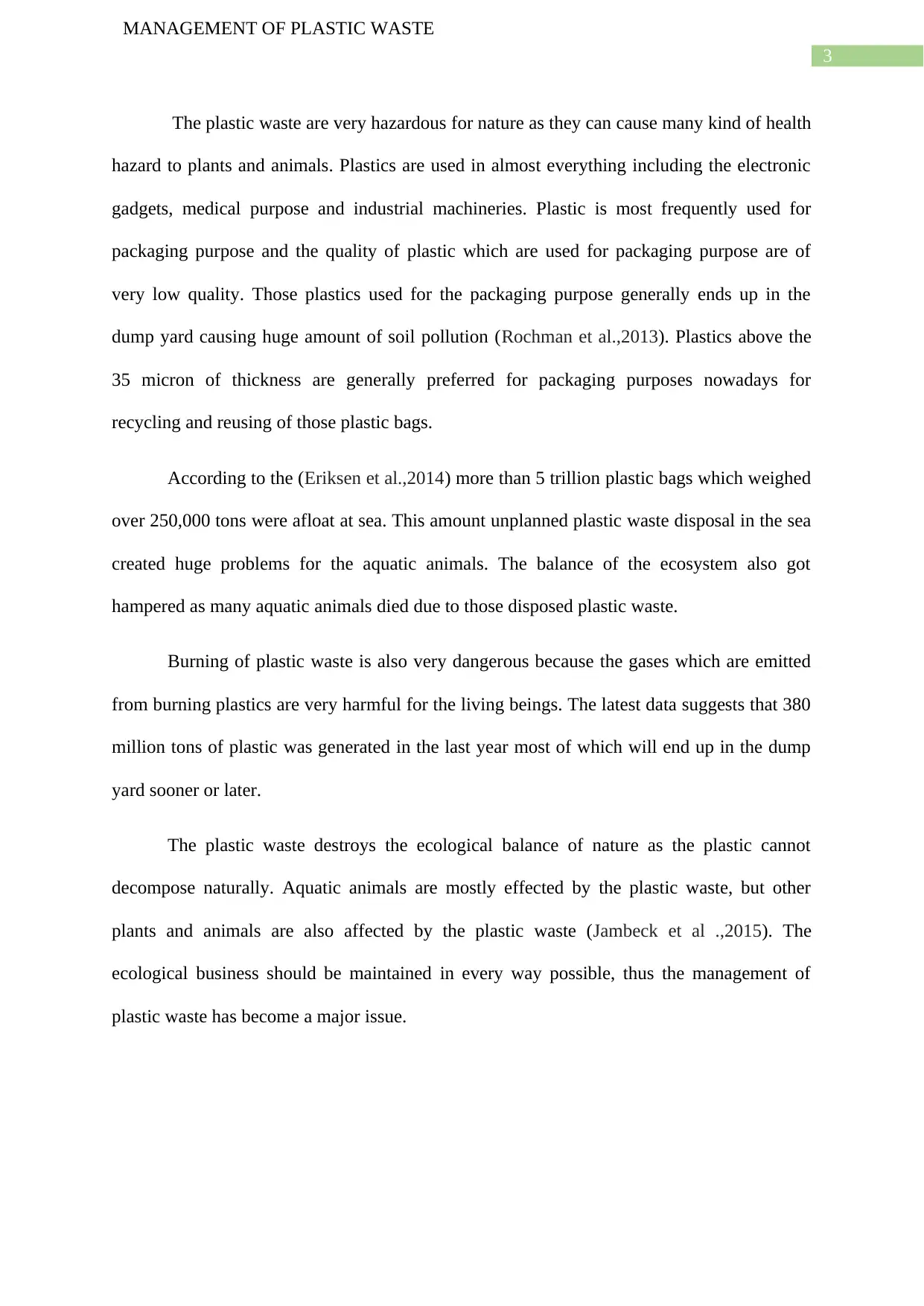
3
MANAGEMENT OF PLASTIC WASTE
The plastic waste are very hazardous for nature as they can cause many kind of health
hazard to plants and animals. Plastics are used in almost everything including the electronic
gadgets, medical purpose and industrial machineries. Plastic is most frequently used for
packaging purpose and the quality of plastic which are used for packaging purpose are of
very low quality. Those plastics used for the packaging purpose generally ends up in the
dump yard causing huge amount of soil pollution (Rochman et al.,2013). Plastics above the
35 micron of thickness are generally preferred for packaging purposes nowadays for
recycling and reusing of those plastic bags.
According to the (Eriksen et al.,2014) more than 5 trillion plastic bags which weighed
over 250,000 tons were afloat at sea. This amount unplanned plastic waste disposal in the sea
created huge problems for the aquatic animals. The balance of the ecosystem also got
hampered as many aquatic animals died due to those disposed plastic waste.
Burning of plastic waste is also very dangerous because the gases which are emitted
from burning plastics are very harmful for the living beings. The latest data suggests that 380
million tons of plastic was generated in the last year most of which will end up in the dump
yard sooner or later.
The plastic waste destroys the ecological balance of nature as the plastic cannot
decompose naturally. Aquatic animals are mostly effected by the plastic waste, but other
plants and animals are also affected by the plastic waste (Jambeck et al .,2015). The
ecological business should be maintained in every way possible, thus the management of
plastic waste has become a major issue.
MANAGEMENT OF PLASTIC WASTE
The plastic waste are very hazardous for nature as they can cause many kind of health
hazard to plants and animals. Plastics are used in almost everything including the electronic
gadgets, medical purpose and industrial machineries. Plastic is most frequently used for
packaging purpose and the quality of plastic which are used for packaging purpose are of
very low quality. Those plastics used for the packaging purpose generally ends up in the
dump yard causing huge amount of soil pollution (Rochman et al.,2013). Plastics above the
35 micron of thickness are generally preferred for packaging purposes nowadays for
recycling and reusing of those plastic bags.
According to the (Eriksen et al.,2014) more than 5 trillion plastic bags which weighed
over 250,000 tons were afloat at sea. This amount unplanned plastic waste disposal in the sea
created huge problems for the aquatic animals. The balance of the ecosystem also got
hampered as many aquatic animals died due to those disposed plastic waste.
Burning of plastic waste is also very dangerous because the gases which are emitted
from burning plastics are very harmful for the living beings. The latest data suggests that 380
million tons of plastic was generated in the last year most of which will end up in the dump
yard sooner or later.
The plastic waste destroys the ecological balance of nature as the plastic cannot
decompose naturally. Aquatic animals are mostly effected by the plastic waste, but other
plants and animals are also affected by the plastic waste (Jambeck et al .,2015). The
ecological business should be maintained in every way possible, thus the management of
plastic waste has become a major issue.
Paraphrase This Document
Need a fresh take? Get an instant paraphrase of this document with our AI Paraphraser
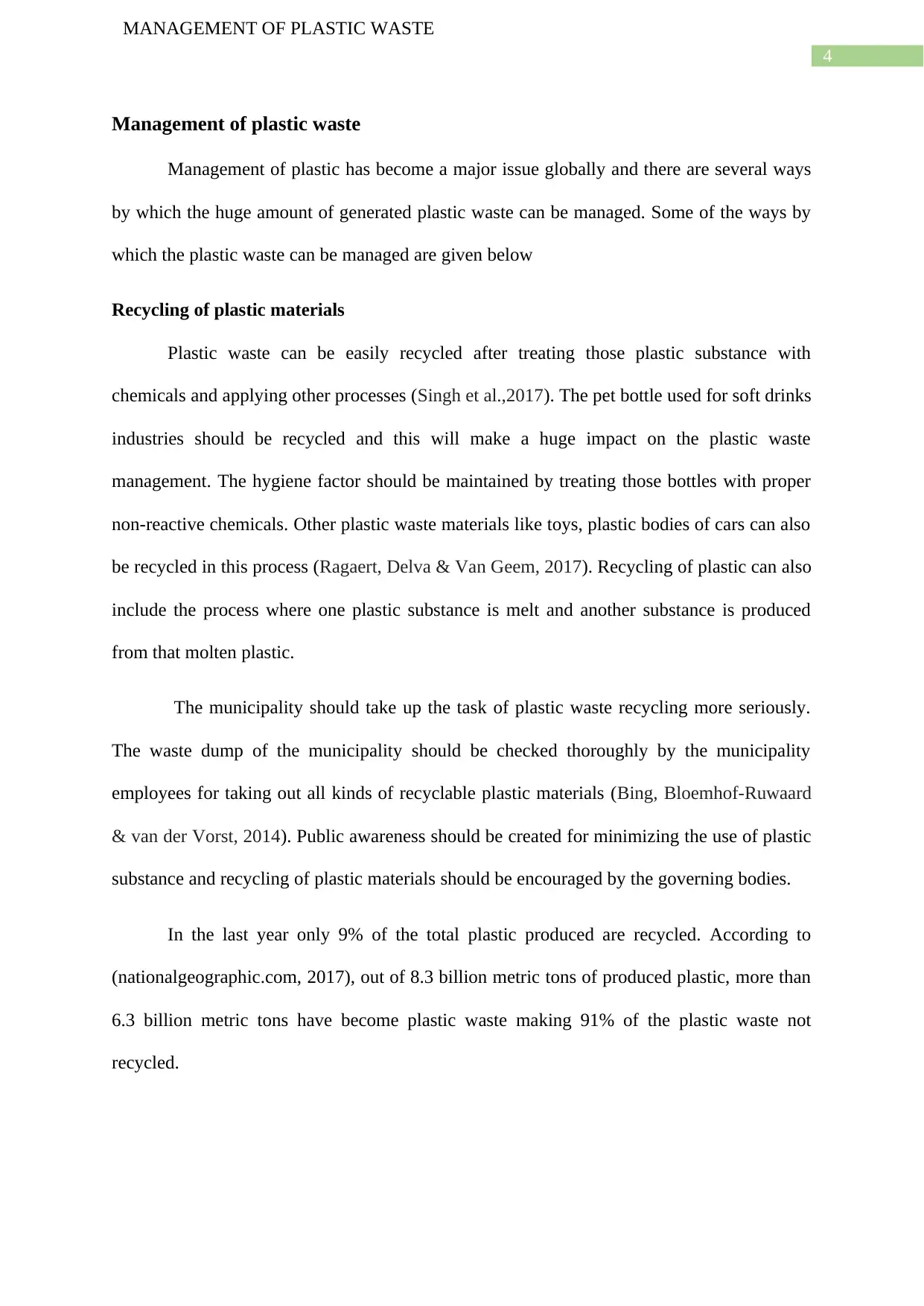
4
MANAGEMENT OF PLASTIC WASTE
Management of plastic waste
Management of plastic has become a major issue globally and there are several ways
by which the huge amount of generated plastic waste can be managed. Some of the ways by
which the plastic waste can be managed are given below
Recycling of plastic materials
Plastic waste can be easily recycled after treating those plastic substance with
chemicals and applying other processes (Singh et al.,2017). The pet bottle used for soft drinks
industries should be recycled and this will make a huge impact on the plastic waste
management. The hygiene factor should be maintained by treating those bottles with proper
non-reactive chemicals. Other plastic waste materials like toys, plastic bodies of cars can also
be recycled in this process (Ragaert, Delva & Van Geem, 2017). Recycling of plastic can also
include the process where one plastic substance is melt and another substance is produced
from that molten plastic.
The municipality should take up the task of plastic waste recycling more seriously.
The waste dump of the municipality should be checked thoroughly by the municipality
employees for taking out all kinds of recyclable plastic materials (Bing, Bloemhof-Ruwaard
& van der Vorst, 2014). Public awareness should be created for minimizing the use of plastic
substance and recycling of plastic materials should be encouraged by the governing bodies.
In the last year only 9% of the total plastic produced are recycled. According to
(nationalgeographic.com, 2017), out of 8.3 billion metric tons of produced plastic, more than
6.3 billion metric tons have become plastic waste making 91% of the plastic waste not
recycled.
MANAGEMENT OF PLASTIC WASTE
Management of plastic waste
Management of plastic has become a major issue globally and there are several ways
by which the huge amount of generated plastic waste can be managed. Some of the ways by
which the plastic waste can be managed are given below
Recycling of plastic materials
Plastic waste can be easily recycled after treating those plastic substance with
chemicals and applying other processes (Singh et al.,2017). The pet bottle used for soft drinks
industries should be recycled and this will make a huge impact on the plastic waste
management. The hygiene factor should be maintained by treating those bottles with proper
non-reactive chemicals. Other plastic waste materials like toys, plastic bodies of cars can also
be recycled in this process (Ragaert, Delva & Van Geem, 2017). Recycling of plastic can also
include the process where one plastic substance is melt and another substance is produced
from that molten plastic.
The municipality should take up the task of plastic waste recycling more seriously.
The waste dump of the municipality should be checked thoroughly by the municipality
employees for taking out all kinds of recyclable plastic materials (Bing, Bloemhof-Ruwaard
& van der Vorst, 2014). Public awareness should be created for minimizing the use of plastic
substance and recycling of plastic materials should be encouraged by the governing bodies.
In the last year only 9% of the total plastic produced are recycled. According to
(nationalgeographic.com, 2017), out of 8.3 billion metric tons of produced plastic, more than
6.3 billion metric tons have become plastic waste making 91% of the plastic waste not
recycled.
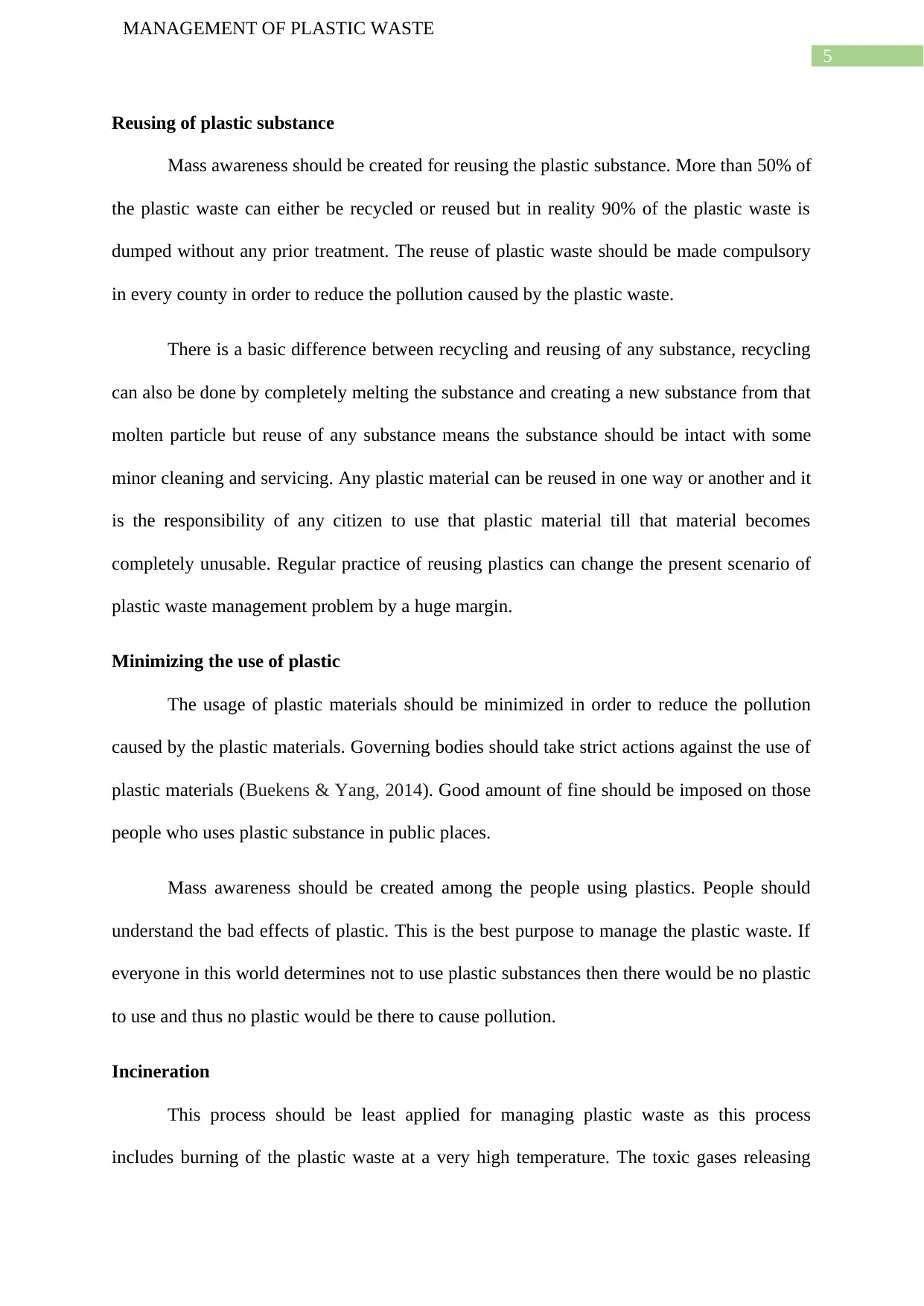
5
MANAGEMENT OF PLASTIC WASTE
Reusing of plastic substance
Mass awareness should be created for reusing the plastic substance. More than 50% of
the plastic waste can either be recycled or reused but in reality 90% of the plastic waste is
dumped without any prior treatment. The reuse of plastic waste should be made compulsory
in every county in order to reduce the pollution caused by the plastic waste.
There is a basic difference between recycling and reusing of any substance, recycling
can also be done by completely melting the substance and creating a new substance from that
molten particle but reuse of any substance means the substance should be intact with some
minor cleaning and servicing. Any plastic material can be reused in one way or another and it
is the responsibility of any citizen to use that plastic material till that material becomes
completely unusable. Regular practice of reusing plastics can change the present scenario of
plastic waste management problem by a huge margin.
Minimizing the use of plastic
The usage of plastic materials should be minimized in order to reduce the pollution
caused by the plastic materials. Governing bodies should take strict actions against the use of
plastic materials (Buekens & Yang, 2014). Good amount of fine should be imposed on those
people who uses plastic substance in public places.
Mass awareness should be created among the people using plastics. People should
understand the bad effects of plastic. This is the best purpose to manage the plastic waste. If
everyone in this world determines not to use plastic substances then there would be no plastic
to use and thus no plastic would be there to cause pollution.
Incineration
This process should be least applied for managing plastic waste as this process
includes burning of the plastic waste at a very high temperature. The toxic gases releasing
MANAGEMENT OF PLASTIC WASTE
Reusing of plastic substance
Mass awareness should be created for reusing the plastic substance. More than 50% of
the plastic waste can either be recycled or reused but in reality 90% of the plastic waste is
dumped without any prior treatment. The reuse of plastic waste should be made compulsory
in every county in order to reduce the pollution caused by the plastic waste.
There is a basic difference between recycling and reusing of any substance, recycling
can also be done by completely melting the substance and creating a new substance from that
molten particle but reuse of any substance means the substance should be intact with some
minor cleaning and servicing. Any plastic material can be reused in one way or another and it
is the responsibility of any citizen to use that plastic material till that material becomes
completely unusable. Regular practice of reusing plastics can change the present scenario of
plastic waste management problem by a huge margin.
Minimizing the use of plastic
The usage of plastic materials should be minimized in order to reduce the pollution
caused by the plastic materials. Governing bodies should take strict actions against the use of
plastic materials (Buekens & Yang, 2014). Good amount of fine should be imposed on those
people who uses plastic substance in public places.
Mass awareness should be created among the people using plastics. People should
understand the bad effects of plastic. This is the best purpose to manage the plastic waste. If
everyone in this world determines not to use plastic substances then there would be no plastic
to use and thus no plastic would be there to cause pollution.
Incineration
This process should be least applied for managing plastic waste as this process
includes burning of the plastic waste at a very high temperature. The toxic gases releasing
⊘ This is a preview!⊘
Do you want full access?
Subscribe today to unlock all pages.

Trusted by 1+ million students worldwide
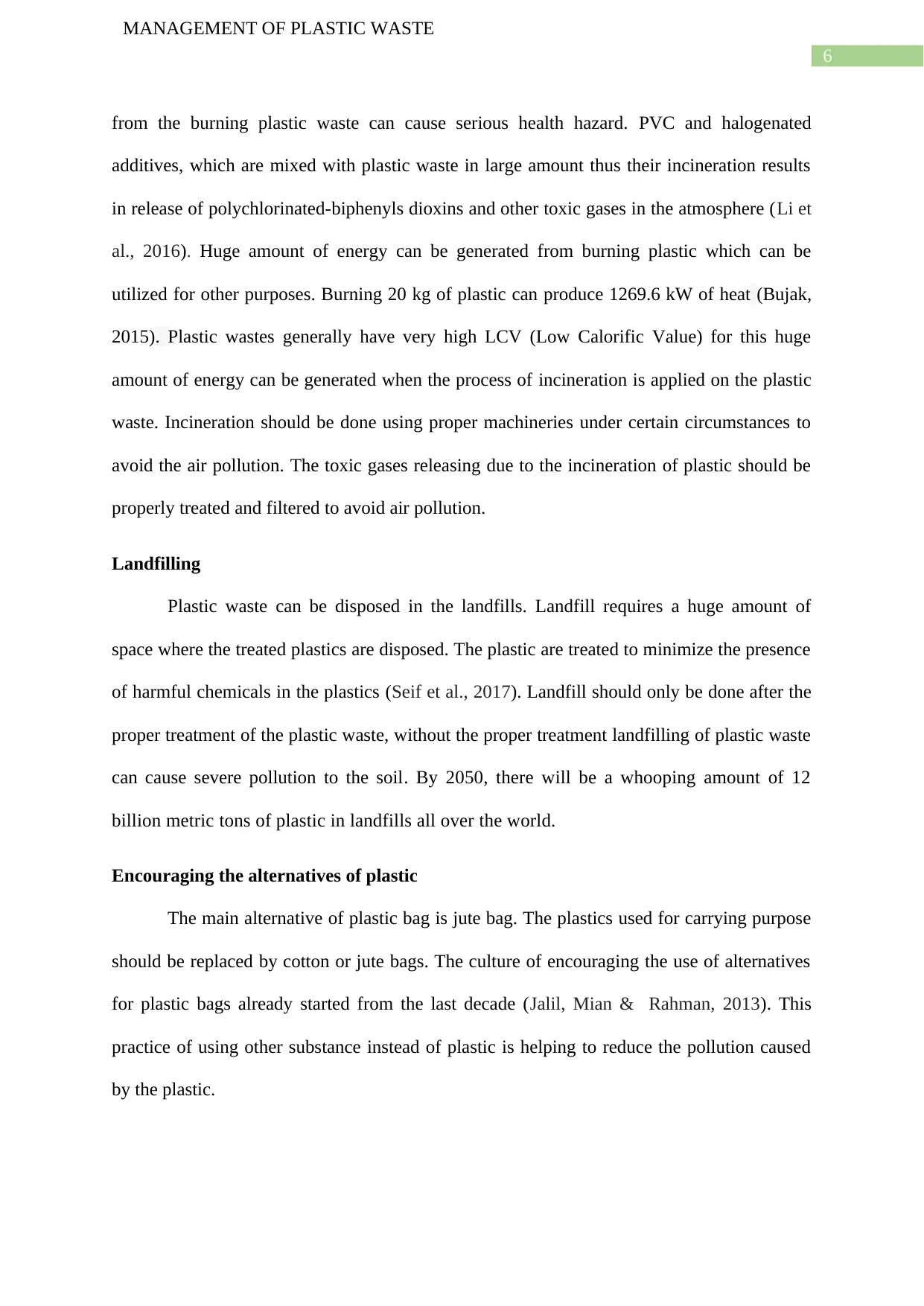
6
MANAGEMENT OF PLASTIC WASTE
from the burning plastic waste can cause serious health hazard. PVC and halogenated
additives, which are mixed with plastic waste in large amount thus their incineration results
in release of polychlorinated-biphenyls dioxins and other toxic gases in the atmosphere (Li et
al., 2016). Huge amount of energy can be generated from burning plastic which can be
utilized for other purposes. Burning 20 kg of plastic can produce 1269.6 kW of heat (Bujak,
2015). Plastic wastes generally have very high LCV (Low Calorific Value) for this huge
amount of energy can be generated when the process of incineration is applied on the plastic
waste. Incineration should be done using proper machineries under certain circumstances to
avoid the air pollution. The toxic gases releasing due to the incineration of plastic should be
properly treated and filtered to avoid air pollution.
Landfilling
Plastic waste can be disposed in the landfills. Landfill requires a huge amount of
space where the treated plastics are disposed. The plastic are treated to minimize the presence
of harmful chemicals in the plastics (Seif et al., 2017). Landfill should only be done after the
proper treatment of the plastic waste, without the proper treatment landfilling of plastic waste
can cause severe pollution to the soil. By 2050, there will be a whooping amount of 12
billion metric tons of plastic in landfills all over the world.
Encouraging the alternatives of plastic
The main alternative of plastic bag is jute bag. The plastics used for carrying purpose
should be replaced by cotton or jute bags. The culture of encouraging the use of alternatives
for plastic bags already started from the last decade (Jalil, Mian & Rahman, 2013). This
practice of using other substance instead of plastic is helping to reduce the pollution caused
by the plastic.
MANAGEMENT OF PLASTIC WASTE
from the burning plastic waste can cause serious health hazard. PVC and halogenated
additives, which are mixed with plastic waste in large amount thus their incineration results
in release of polychlorinated-biphenyls dioxins and other toxic gases in the atmosphere (Li et
al., 2016). Huge amount of energy can be generated from burning plastic which can be
utilized for other purposes. Burning 20 kg of plastic can produce 1269.6 kW of heat (Bujak,
2015). Plastic wastes generally have very high LCV (Low Calorific Value) for this huge
amount of energy can be generated when the process of incineration is applied on the plastic
waste. Incineration should be done using proper machineries under certain circumstances to
avoid the air pollution. The toxic gases releasing due to the incineration of plastic should be
properly treated and filtered to avoid air pollution.
Landfilling
Plastic waste can be disposed in the landfills. Landfill requires a huge amount of
space where the treated plastics are disposed. The plastic are treated to minimize the presence
of harmful chemicals in the plastics (Seif et al., 2017). Landfill should only be done after the
proper treatment of the plastic waste, without the proper treatment landfilling of plastic waste
can cause severe pollution to the soil. By 2050, there will be a whooping amount of 12
billion metric tons of plastic in landfills all over the world.
Encouraging the alternatives of plastic
The main alternative of plastic bag is jute bag. The plastics used for carrying purpose
should be replaced by cotton or jute bags. The culture of encouraging the use of alternatives
for plastic bags already started from the last decade (Jalil, Mian & Rahman, 2013). This
practice of using other substance instead of plastic is helping to reduce the pollution caused
by the plastic.
Paraphrase This Document
Need a fresh take? Get an instant paraphrase of this document with our AI Paraphraser
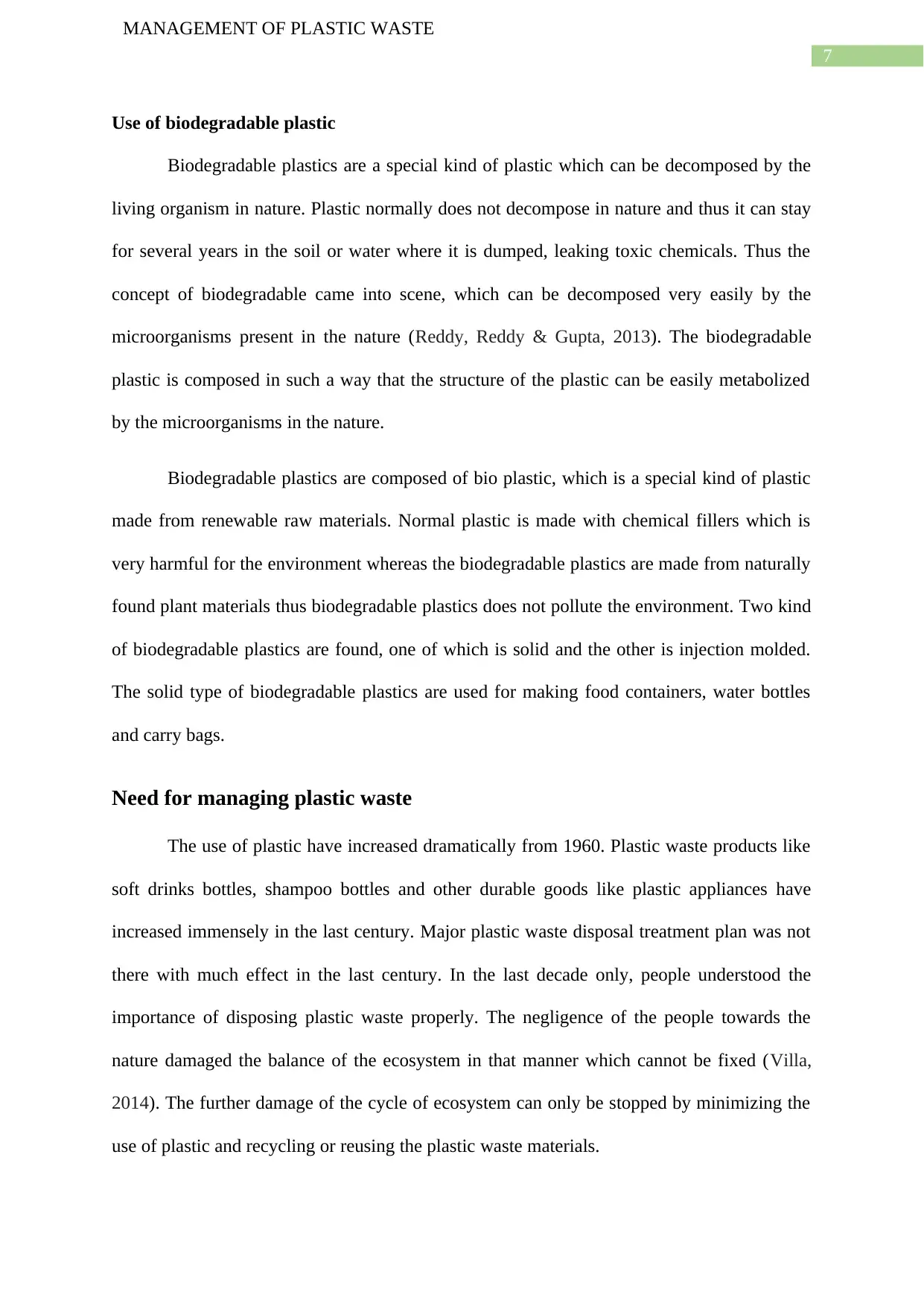
7
MANAGEMENT OF PLASTIC WASTE
Use of biodegradable plastic
Biodegradable plastics are a special kind of plastic which can be decomposed by the
living organism in nature. Plastic normally does not decompose in nature and thus it can stay
for several years in the soil or water where it is dumped, leaking toxic chemicals. Thus the
concept of biodegradable came into scene, which can be decomposed very easily by the
microorganisms present in the nature (Reddy, Reddy & Gupta, 2013). The biodegradable
plastic is composed in such a way that the structure of the plastic can be easily metabolized
by the microorganisms in the nature.
Biodegradable plastics are composed of bio plastic, which is a special kind of plastic
made from renewable raw materials. Normal plastic is made with chemical fillers which is
very harmful for the environment whereas the biodegradable plastics are made from naturally
found plant materials thus biodegradable plastics does not pollute the environment. Two kind
of biodegradable plastics are found, one of which is solid and the other is injection molded.
The solid type of biodegradable plastics are used for making food containers, water bottles
and carry bags.
Need for managing plastic waste
The use of plastic have increased dramatically from 1960. Plastic waste products like
soft drinks bottles, shampoo bottles and other durable goods like plastic appliances have
increased immensely in the last century. Major plastic waste disposal treatment plan was not
there with much effect in the last century. In the last decade only, people understood the
importance of disposing plastic waste properly. The negligence of the people towards the
nature damaged the balance of the ecosystem in that manner which cannot be fixed (Villa,
2014). The further damage of the cycle of ecosystem can only be stopped by minimizing the
use of plastic and recycling or reusing the plastic waste materials.
MANAGEMENT OF PLASTIC WASTE
Use of biodegradable plastic
Biodegradable plastics are a special kind of plastic which can be decomposed by the
living organism in nature. Plastic normally does not decompose in nature and thus it can stay
for several years in the soil or water where it is dumped, leaking toxic chemicals. Thus the
concept of biodegradable came into scene, which can be decomposed very easily by the
microorganisms present in the nature (Reddy, Reddy & Gupta, 2013). The biodegradable
plastic is composed in such a way that the structure of the plastic can be easily metabolized
by the microorganisms in the nature.
Biodegradable plastics are composed of bio plastic, which is a special kind of plastic
made from renewable raw materials. Normal plastic is made with chemical fillers which is
very harmful for the environment whereas the biodegradable plastics are made from naturally
found plant materials thus biodegradable plastics does not pollute the environment. Two kind
of biodegradable plastics are found, one of which is solid and the other is injection molded.
The solid type of biodegradable plastics are used for making food containers, water bottles
and carry bags.
Need for managing plastic waste
The use of plastic have increased dramatically from 1960. Plastic waste products like
soft drinks bottles, shampoo bottles and other durable goods like plastic appliances have
increased immensely in the last century. Major plastic waste disposal treatment plan was not
there with much effect in the last century. In the last decade only, people understood the
importance of disposing plastic waste properly. The negligence of the people towards the
nature damaged the balance of the ecosystem in that manner which cannot be fixed (Villa,
2014). The further damage of the cycle of ecosystem can only be stopped by minimizing the
use of plastic and recycling or reusing the plastic waste materials.
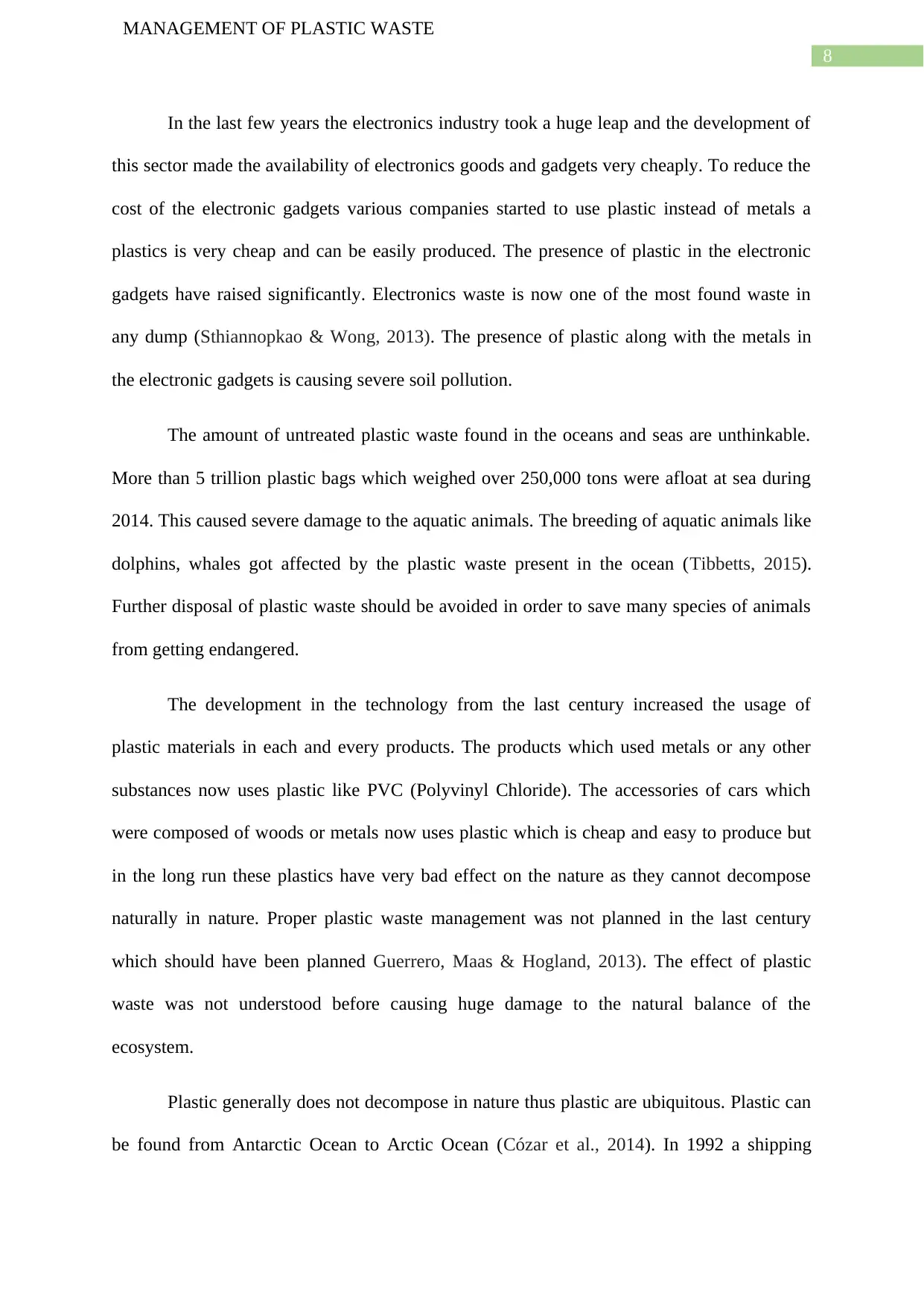
8
MANAGEMENT OF PLASTIC WASTE
In the last few years the electronics industry took a huge leap and the development of
this sector made the availability of electronics goods and gadgets very cheaply. To reduce the
cost of the electronic gadgets various companies started to use plastic instead of metals a
plastics is very cheap and can be easily produced. The presence of plastic in the electronic
gadgets have raised significantly. Electronics waste is now one of the most found waste in
any dump (Sthiannopkao & Wong, 2013). The presence of plastic along with the metals in
the electronic gadgets is causing severe soil pollution.
The amount of untreated plastic waste found in the oceans and seas are unthinkable.
More than 5 trillion plastic bags which weighed over 250,000 tons were afloat at sea during
2014. This caused severe damage to the aquatic animals. The breeding of aquatic animals like
dolphins, whales got affected by the plastic waste present in the ocean (Tibbetts, 2015).
Further disposal of plastic waste should be avoided in order to save many species of animals
from getting endangered.
The development in the technology from the last century increased the usage of
plastic materials in each and every products. The products which used metals or any other
substances now uses plastic like PVC (Polyvinyl Chloride). The accessories of cars which
were composed of woods or metals now uses plastic which is cheap and easy to produce but
in the long run these plastics have very bad effect on the nature as they cannot decompose
naturally in nature. Proper plastic waste management was not planned in the last century
which should have been planned Guerrero, Maas & Hogland, 2013). The effect of plastic
waste was not understood before causing huge damage to the natural balance of the
ecosystem.
Plastic generally does not decompose in nature thus plastic are ubiquitous. Plastic can
be found from Antarctic Ocean to Arctic Ocean (Cózar et al., 2014). In 1992 a shipping
MANAGEMENT OF PLASTIC WASTE
In the last few years the electronics industry took a huge leap and the development of
this sector made the availability of electronics goods and gadgets very cheaply. To reduce the
cost of the electronic gadgets various companies started to use plastic instead of metals a
plastics is very cheap and can be easily produced. The presence of plastic in the electronic
gadgets have raised significantly. Electronics waste is now one of the most found waste in
any dump (Sthiannopkao & Wong, 2013). The presence of plastic along with the metals in
the electronic gadgets is causing severe soil pollution.
The amount of untreated plastic waste found in the oceans and seas are unthinkable.
More than 5 trillion plastic bags which weighed over 250,000 tons were afloat at sea during
2014. This caused severe damage to the aquatic animals. The breeding of aquatic animals like
dolphins, whales got affected by the plastic waste present in the ocean (Tibbetts, 2015).
Further disposal of plastic waste should be avoided in order to save many species of animals
from getting endangered.
The development in the technology from the last century increased the usage of
plastic materials in each and every products. The products which used metals or any other
substances now uses plastic like PVC (Polyvinyl Chloride). The accessories of cars which
were composed of woods or metals now uses plastic which is cheap and easy to produce but
in the long run these plastics have very bad effect on the nature as they cannot decompose
naturally in nature. Proper plastic waste management was not planned in the last century
which should have been planned Guerrero, Maas & Hogland, 2013). The effect of plastic
waste was not understood before causing huge damage to the natural balance of the
ecosystem.
Plastic generally does not decompose in nature thus plastic are ubiquitous. Plastic can
be found from Antarctic Ocean to Arctic Ocean (Cózar et al., 2014). In 1992 a shipping
⊘ This is a preview!⊘
Do you want full access?
Subscribe today to unlock all pages.

Trusted by 1+ million students worldwide
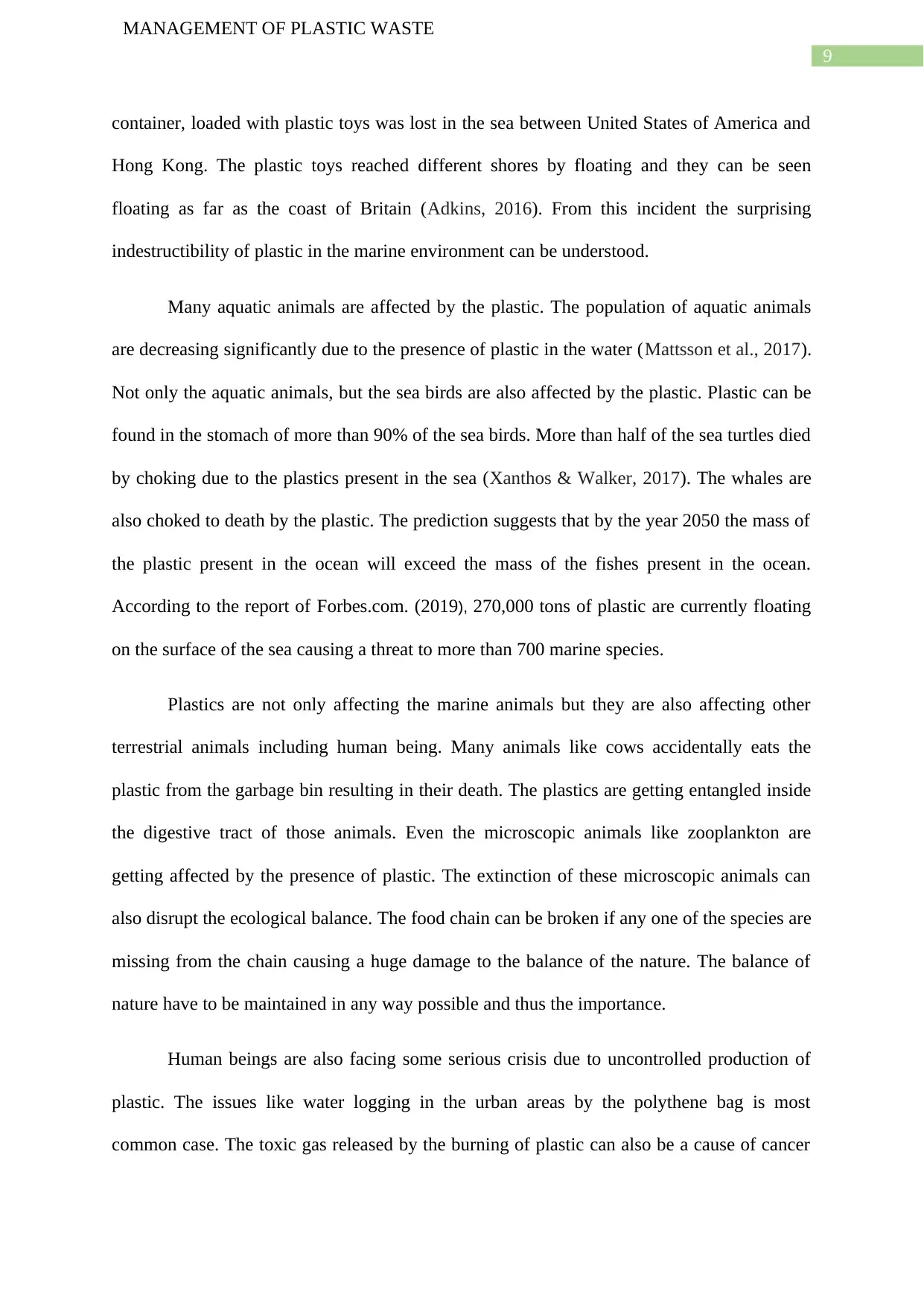
9
MANAGEMENT OF PLASTIC WASTE
container, loaded with plastic toys was lost in the sea between United States of America and
Hong Kong. The plastic toys reached different shores by floating and they can be seen
floating as far as the coast of Britain (Adkins, 2016). From this incident the surprising
indestructibility of plastic in the marine environment can be understood.
Many aquatic animals are affected by the plastic. The population of aquatic animals
are decreasing significantly due to the presence of plastic in the water (Mattsson et al., 2017).
Not only the aquatic animals, but the sea birds are also affected by the plastic. Plastic can be
found in the stomach of more than 90% of the sea birds. More than half of the sea turtles died
by choking due to the plastics present in the sea (Xanthos & Walker, 2017). The whales are
also choked to death by the plastic. The prediction suggests that by the year 2050 the mass of
the plastic present in the ocean will exceed the mass of the fishes present in the ocean.
According to the report of Forbes.com. (2019), 270,000 tons of plastic are currently floating
on the surface of the sea causing a threat to more than 700 marine species.
Plastics are not only affecting the marine animals but they are also affecting other
terrestrial animals including human being. Many animals like cows accidentally eats the
plastic from the garbage bin resulting in their death. The plastics are getting entangled inside
the digestive tract of those animals. Even the microscopic animals like zooplankton are
getting affected by the presence of plastic. The extinction of these microscopic animals can
also disrupt the ecological balance. The food chain can be broken if any one of the species are
missing from the chain causing a huge damage to the balance of the nature. The balance of
nature have to be maintained in any way possible and thus the importance.
Human beings are also facing some serious crisis due to uncontrolled production of
plastic. The issues like water logging in the urban areas by the polythene bag is most
common case. The toxic gas released by the burning of plastic can also be a cause of cancer
MANAGEMENT OF PLASTIC WASTE
container, loaded with plastic toys was lost in the sea between United States of America and
Hong Kong. The plastic toys reached different shores by floating and they can be seen
floating as far as the coast of Britain (Adkins, 2016). From this incident the surprising
indestructibility of plastic in the marine environment can be understood.
Many aquatic animals are affected by the plastic. The population of aquatic animals
are decreasing significantly due to the presence of plastic in the water (Mattsson et al., 2017).
Not only the aquatic animals, but the sea birds are also affected by the plastic. Plastic can be
found in the stomach of more than 90% of the sea birds. More than half of the sea turtles died
by choking due to the plastics present in the sea (Xanthos & Walker, 2017). The whales are
also choked to death by the plastic. The prediction suggests that by the year 2050 the mass of
the plastic present in the ocean will exceed the mass of the fishes present in the ocean.
According to the report of Forbes.com. (2019), 270,000 tons of plastic are currently floating
on the surface of the sea causing a threat to more than 700 marine species.
Plastics are not only affecting the marine animals but they are also affecting other
terrestrial animals including human being. Many animals like cows accidentally eats the
plastic from the garbage bin resulting in their death. The plastics are getting entangled inside
the digestive tract of those animals. Even the microscopic animals like zooplankton are
getting affected by the presence of plastic. The extinction of these microscopic animals can
also disrupt the ecological balance. The food chain can be broken if any one of the species are
missing from the chain causing a huge damage to the balance of the nature. The balance of
nature have to be maintained in any way possible and thus the importance.
Human beings are also facing some serious crisis due to uncontrolled production of
plastic. The issues like water logging in the urban areas by the polythene bag is most
common case. The toxic gas released by the burning of plastic can also be a cause of cancer
Paraphrase This Document
Need a fresh take? Get an instant paraphrase of this document with our AI Paraphraser
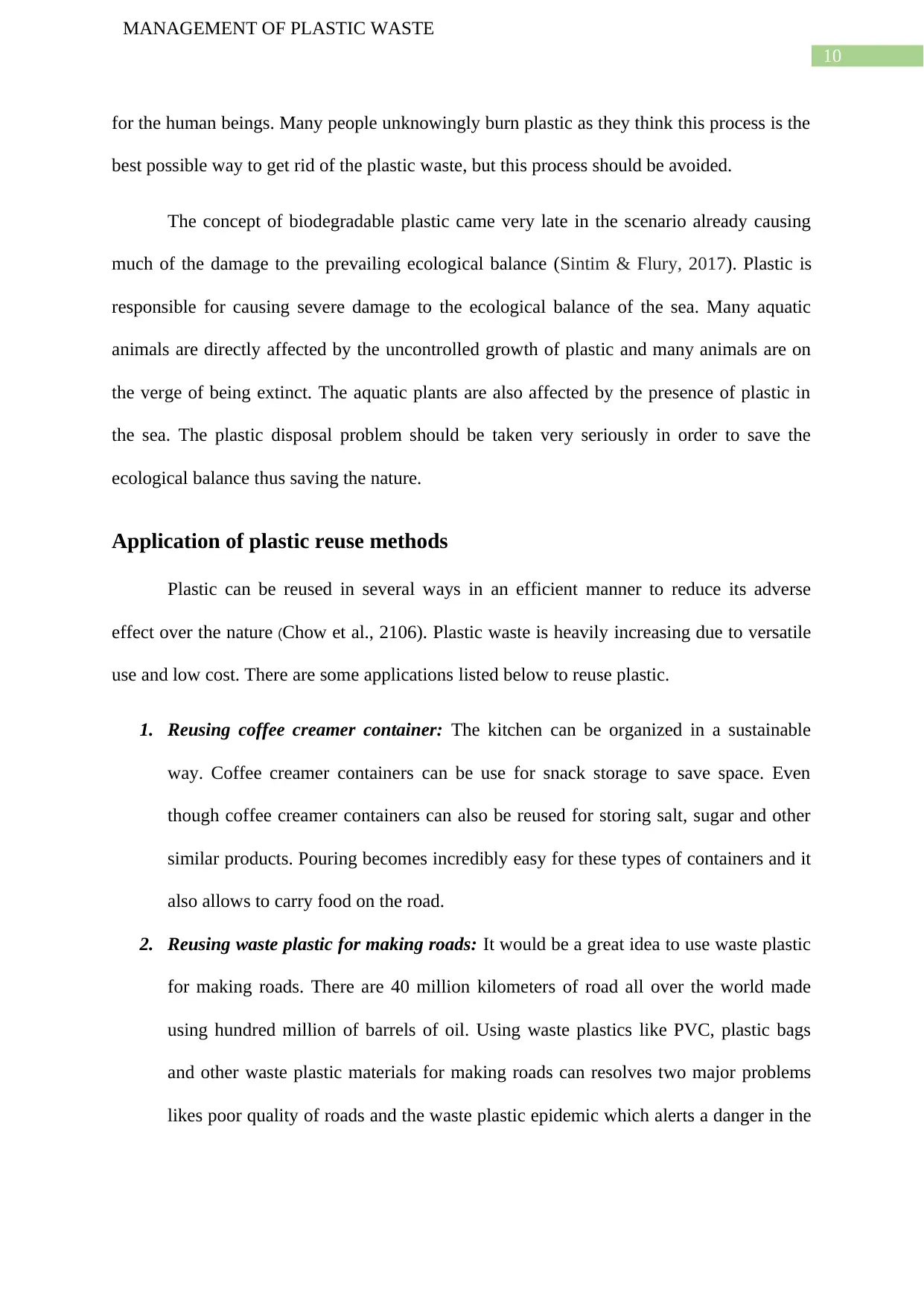
10
MANAGEMENT OF PLASTIC WASTE
for the human beings. Many people unknowingly burn plastic as they think this process is the
best possible way to get rid of the plastic waste, but this process should be avoided.
The concept of biodegradable plastic came very late in the scenario already causing
much of the damage to the prevailing ecological balance (Sintim & Flury, 2017). Plastic is
responsible for causing severe damage to the ecological balance of the sea. Many aquatic
animals are directly affected by the uncontrolled growth of plastic and many animals are on
the verge of being extinct. The aquatic plants are also affected by the presence of plastic in
the sea. The plastic disposal problem should be taken very seriously in order to save the
ecological balance thus saving the nature.
Application of plastic reuse methods
Plastic can be reused in several ways in an efficient manner to reduce its adverse
effect over the nature (Chow et al., 2106). Plastic waste is heavily increasing due to versatile
use and low cost. There are some applications listed below to reuse plastic.
1. Reusing coffee creamer container: The kitchen can be organized in a sustainable
way. Coffee creamer containers can be use for snack storage to save space. Even
though coffee creamer containers can also be reused for storing salt, sugar and other
similar products. Pouring becomes incredibly easy for these types of containers and it
also allows to carry food on the road.
2. Reusing waste plastic for making roads: It would be a great idea to use waste plastic
for making roads. There are 40 million kilometers of road all over the world made
using hundred million of barrels of oil. Using waste plastics like PVC, plastic bags
and other waste plastic materials for making roads can resolves two major problems
likes poor quality of roads and the waste plastic epidemic which alerts a danger in the
MANAGEMENT OF PLASTIC WASTE
for the human beings. Many people unknowingly burn plastic as they think this process is the
best possible way to get rid of the plastic waste, but this process should be avoided.
The concept of biodegradable plastic came very late in the scenario already causing
much of the damage to the prevailing ecological balance (Sintim & Flury, 2017). Plastic is
responsible for causing severe damage to the ecological balance of the sea. Many aquatic
animals are directly affected by the uncontrolled growth of plastic and many animals are on
the verge of being extinct. The aquatic plants are also affected by the presence of plastic in
the sea. The plastic disposal problem should be taken very seriously in order to save the
ecological balance thus saving the nature.
Application of plastic reuse methods
Plastic can be reused in several ways in an efficient manner to reduce its adverse
effect over the nature (Chow et al., 2106). Plastic waste is heavily increasing due to versatile
use and low cost. There are some applications listed below to reuse plastic.
1. Reusing coffee creamer container: The kitchen can be organized in a sustainable
way. Coffee creamer containers can be use for snack storage to save space. Even
though coffee creamer containers can also be reused for storing salt, sugar and other
similar products. Pouring becomes incredibly easy for these types of containers and it
also allows to carry food on the road.
2. Reusing waste plastic for making roads: It would be a great idea to use waste plastic
for making roads. There are 40 million kilometers of road all over the world made
using hundred million of barrels of oil. Using waste plastics like PVC, plastic bags
and other waste plastic materials for making roads can resolves two major problems
likes poor quality of roads and the waste plastic epidemic which alerts a danger in the
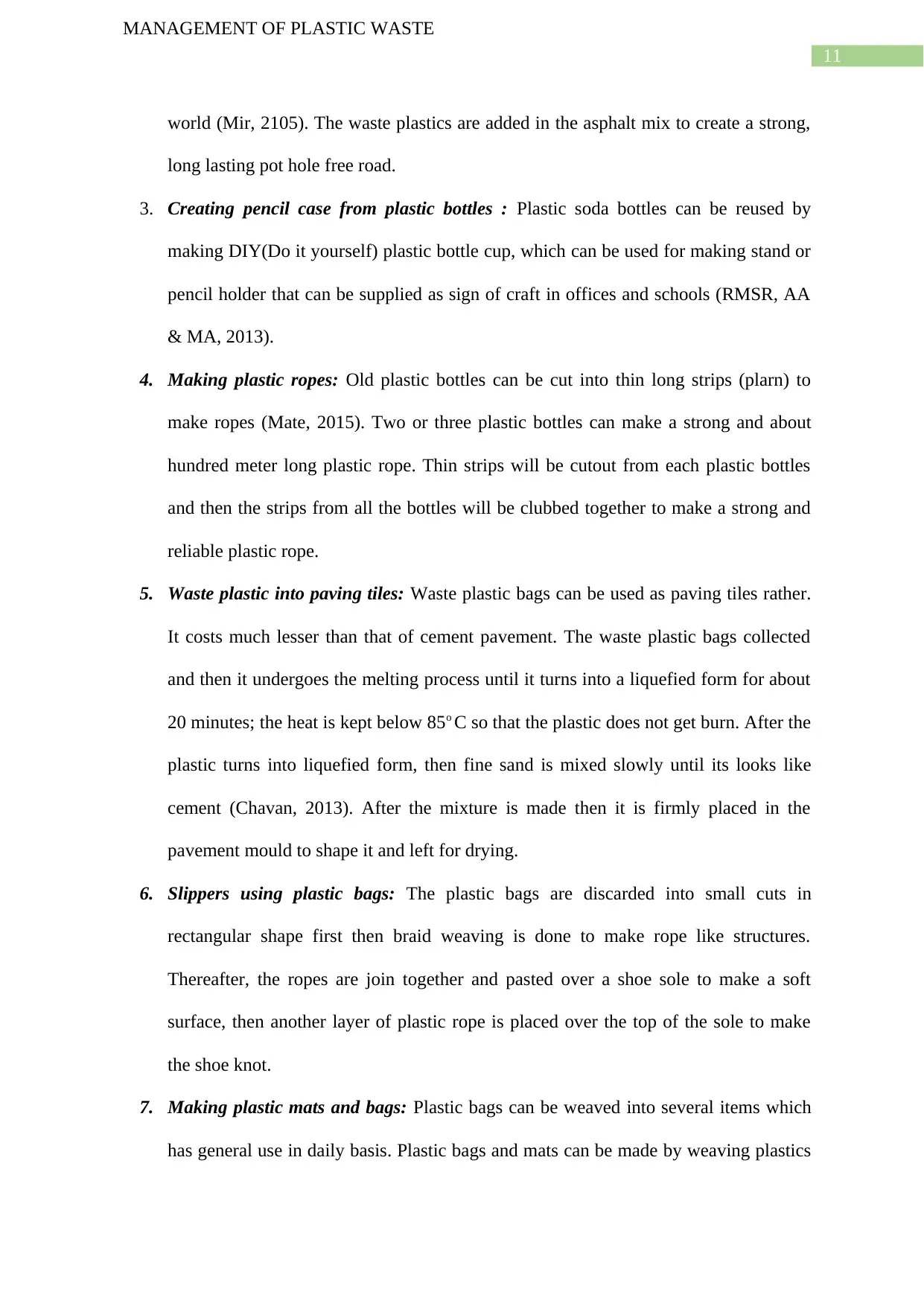
11
MANAGEMENT OF PLASTIC WASTE
world (Mir, 2105). The waste plastics are added in the asphalt mix to create a strong,
long lasting pot hole free road.
3. Creating pencil case from plastic bottles : Plastic soda bottles can be reused by
making DIY(Do it yourself) plastic bottle cup, which can be used for making stand or
pencil holder that can be supplied as sign of craft in offices and schools (RMSR, AA
& MA, 2013).
4. Making plastic ropes: Old plastic bottles can be cut into thin long strips (plarn) to
make ropes (Mate, 2015). Two or three plastic bottles can make a strong and about
hundred meter long plastic rope. Thin strips will be cutout from each plastic bottles
and then the strips from all the bottles will be clubbed together to make a strong and
reliable plastic rope.
5. Waste plastic into paving tiles: Waste plastic bags can be used as paving tiles rather.
It costs much lesser than that of cement pavement. The waste plastic bags collected
and then it undergoes the melting process until it turns into a liquefied form for about
20 minutes; the heat is kept below 85o C so that the plastic does not get burn. After the
plastic turns into liquefied form, then fine sand is mixed slowly until its looks like
cement (Chavan, 2013). After the mixture is made then it is firmly placed in the
pavement mould to shape it and left for drying.
6. Slippers using plastic bags: The plastic bags are discarded into small cuts in
rectangular shape first then braid weaving is done to make rope like structures.
Thereafter, the ropes are join together and pasted over a shoe sole to make a soft
surface, then another layer of plastic rope is placed over the top of the sole to make
the shoe knot.
7. Making plastic mats and bags: Plastic bags can be weaved into several items which
has general use in daily basis. Plastic bags and mats can be made by weaving plastics
MANAGEMENT OF PLASTIC WASTE
world (Mir, 2105). The waste plastics are added in the asphalt mix to create a strong,
long lasting pot hole free road.
3. Creating pencil case from plastic bottles : Plastic soda bottles can be reused by
making DIY(Do it yourself) plastic bottle cup, which can be used for making stand or
pencil holder that can be supplied as sign of craft in offices and schools (RMSR, AA
& MA, 2013).
4. Making plastic ropes: Old plastic bottles can be cut into thin long strips (plarn) to
make ropes (Mate, 2015). Two or three plastic bottles can make a strong and about
hundred meter long plastic rope. Thin strips will be cutout from each plastic bottles
and then the strips from all the bottles will be clubbed together to make a strong and
reliable plastic rope.
5. Waste plastic into paving tiles: Waste plastic bags can be used as paving tiles rather.
It costs much lesser than that of cement pavement. The waste plastic bags collected
and then it undergoes the melting process until it turns into a liquefied form for about
20 minutes; the heat is kept below 85o C so that the plastic does not get burn. After the
plastic turns into liquefied form, then fine sand is mixed slowly until its looks like
cement (Chavan, 2013). After the mixture is made then it is firmly placed in the
pavement mould to shape it and left for drying.
6. Slippers using plastic bags: The plastic bags are discarded into small cuts in
rectangular shape first then braid weaving is done to make rope like structures.
Thereafter, the ropes are join together and pasted over a shoe sole to make a soft
surface, then another layer of plastic rope is placed over the top of the sole to make
the shoe knot.
7. Making plastic mats and bags: Plastic bags can be weaved into several items which
has general use in daily basis. Plastic bags and mats can be made by weaving plastics
⊘ This is a preview!⊘
Do you want full access?
Subscribe today to unlock all pages.

Trusted by 1+ million students worldwide
1 out of 20
Related Documents
Your All-in-One AI-Powered Toolkit for Academic Success.
+13062052269
info@desklib.com
Available 24*7 on WhatsApp / Email
![[object Object]](/_next/static/media/star-bottom.7253800d.svg)
Unlock your academic potential
Copyright © 2020–2025 A2Z Services. All Rights Reserved. Developed and managed by ZUCOL.





